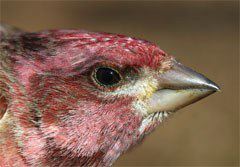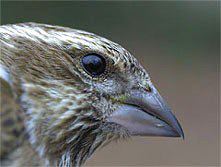TREE BARK BAFFLER #1:
The Answers
With the arrival of winter, many trees at Hilton Pond Center have lost their leaves, making identification a bit more difficult. Last week, with the debut of Tree Bark Baffler #1, we challenged you to take a look at photos of trunks from six native Piedmont trees to see if you could figure out what species they were without using hints such as leaf shape, twig configuration, or overall silhouette. This week, we're letting you see how you did by checking your answers against the descriptions below.
All text & photos © Hilton Pond Center
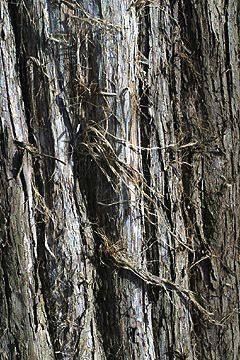 Tree Bark Specimen #1 Tree Bark Specimen #1
|
Juniperus virginiana
This quintessential evergreen of the Carolina Piedmont (and beyond) has reddish bark that often gets shredded by Southern Flying Squirrels who use it for bedding. The common name comes from the bright red heartwood rather than the trunk. These trees are sun-lovers that grow best in open fields; as broadleaf species increase in density at Hilton Pond Center, many smaller Eastern Red Cedars get shaded out and grow more spindly, or die.
|
|
Cornus florida
Dogwoods are understory trees that do best in full or partial shade, where they grow slowly and produce bark that becomes blocky and furrowed. This photo is a closeup; the bark blocks are half-inch squares. (Some folks say the bark of this tree resembles alligator hide, and that you can always identify a DOGwood by its BARK.) Many Flowering Dogwoods at Hilton Pond Center were delimbed or crushed during recent storms when ice-laden branches fell on them from canopy trees.
|
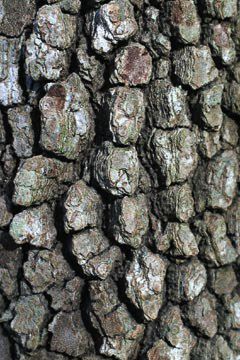 Tree Bark Specimen #2 Tree Bark Specimen #2
|
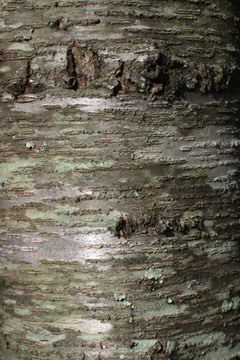 Tree Bark Specimen #3 Tree Bark Specimen #3
|
Prunus serotina
Until they reach trunk diameters of more than six inches, Black Cherries have smooth bark that is marked by tiny horizontal lines. These blister-like structures are "lenticels," which assist with gaseous exchange. Often, the trunk of a cherry is also marked by pale gray or green splotches of crustose or foliose lichens. Older Black Cherry trees at Hilton Pond Center have bark that is rough and nearly black.
|
Southern Red Oak
Quercus falcata
This species of oak is common across the southern U.S., where it attains great size and girth. A mature trunk is marked by long, straight ridges that are lightly furrowed. One large specimen at Hilton Pond Center was snapped off at the base during the December 2002 ice storm because the species tends to hold its dead leaves, creating a large surface area on which ice can form and weigh down the tree. |
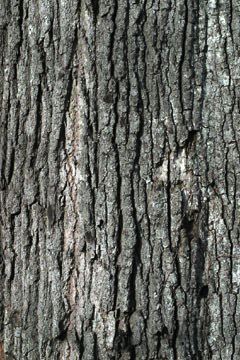 Tree Bark Specimen #4 Tree Bark Specimen #4
|
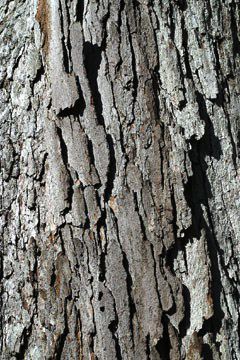 Tree Bark Specimen #5 Tree Bark Specimen #5
|
In the right conditions, White Oaks also grow tall and wide. Their pale gray bark forms distinctive overlapping layers that may flake off as the trunk increases in diameter. An old White Oak specimen is by far the biggest tree at Hilton Pond Center; it reaches more than 100 feet into the sky and has a trunk almost 15 feet in circumference.
|
Pecan
Carya illinoinensis
This member of the hickory family grows unusual bark; in old specimens there are shallow grooves that look almost as if they had been carved out by a round wood chisel. Several Pecans at Hilton Pond Center are quite large; the one in the photo measures seven feet around the trunk. Each year these trees produce lots of nuts that never hit the ground--thanks to the local Gray Squirrel population.
|
 Tree Bark Specimen #6 Tree Bark Specimen #6
|
Entries sent in response to Tree Bark Baffler #1 bore out our comment in the first paragraph above: trees are indeed hard to identify from bark alone, especially without any frame of reference such as texture, terminal bud, tree shape, habitat, etc. We regret that no one identified all six trees correctly; in fact, four out of six was the best anyone did, but thanks go out to all who entered.
Nearly everyone got #3 Black Cherry right; fortunately, we didn't include a photo of a really old specimen at Hilton Pond Center that lacks the tell-tale lenticels. The most commonly missed tree was #6 Pecan, which was the one we thought would be hardest;  no one identified it correctly, although fellow Newberry College graduate Dan Koon of Columbia SC (left) did place it correctly in the Hickory Family so we're awarding him half a point; he also got four other IDs correct to earn a score of 4.5 out of 6. Several entries confused #1 Eastern Red Cedar with Bald Cypress (Taxodium distichum); the latter has bark that can be similar in color to red cedar's, but it isn't stringy. Also confusing was the blocky bark of #2 Flowering Dogwood, which some folks thought was Common Persimmon (Diospyros virginiana); persimmon bark typically has much deeper furrows with blocks that are more pointed rather than flat. #4 Southern Red Oak, whose bark is somewhat nondescript, was a puzzler for the majority of entrants; the overlapping ridges of #5 White Oak proved much easier to identify. no one identified it correctly, although fellow Newberry College graduate Dan Koon of Columbia SC (left) did place it correctly in the Hickory Family so we're awarding him half a point; he also got four other IDs correct to earn a score of 4.5 out of 6. Several entries confused #1 Eastern Red Cedar with Bald Cypress (Taxodium distichum); the latter has bark that can be similar in color to red cedar's, but it isn't stringy. Also confusing was the blocky bark of #2 Flowering Dogwood, which some folks thought was Common Persimmon (Diospyros virginiana); persimmon bark typically has much deeper furrows with blocks that are more pointed rather than flat. #4 Southern Red Oak, whose bark is somewhat nondescript, was a puzzler for the majority of entrants; the overlapping ridges of #5 White Oak proved much easier to identify.
Unfortunately for Dan Koon, 4.5 isn't high enough to earn the coveted Operation RubyThroat T-shirt prize, but his score will give him bragging rights until a future Tree Bark Baffler #2. Until then, we'll continue studying trees at Hilton Pond Center--just in case we bump into Dan someday and he asks us to perform the baffling task of identifying photos of bark specimens from his own backyard.
All text & photos © Hilton Pond Center
If you enjoy "This Week at Hilton Pond," please help Support
Hilton Pond Center for Piedmont Natural History.
It's painless, and YOU can make a difference!
You may wish to consult our Index of all nature topics covered since February 2000.
For a free, non-fattening, on-line subscription to "This Week at Hilton Pond," just send an e-mail with "Subscribe" in the subject line to THIS WEEK
|

 Tree Bark Specimen #1
Tree Bark Specimen #1 Tree Bark Specimen #2
Tree Bark Specimen #2 Tree Bark Specimen #3
Tree Bark Specimen #3 Tree Bark Specimen #4
Tree Bark Specimen #4 Tree Bark Specimen #5
Tree Bark Specimen #5 Tree Bark Specimen #6
Tree Bark Specimen #6 no one identified it correctly, although fellow Newberry College graduate Dan Koon of Columbia SC (left) did place it correctly in the Hickory Family so we're awarding him half a point; he also got four other IDs correct to earn a score of 4.5 out of 6. Several entries confused #1 Eastern Red Cedar with Bald Cypress (Taxodium distichum); the latter has bark that can be similar in color to red cedar's, but it isn't stringy. Also confusing was the blocky bark of #2 Flowering Dogwood, which some folks thought was Common Persimmon (Diospyros virginiana); persimmon bark typically has much deeper furrows with blocks that are more pointed rather than flat. #4 Southern Red Oak, whose bark is somewhat nondescript, was a puzzler for the majority of entrants; the overlapping ridges of #5 White Oak proved much easier to identify.
no one identified it correctly, although fellow Newberry College graduate Dan Koon of Columbia SC (left) did place it correctly in the Hickory Family so we're awarding him half a point; he also got four other IDs correct to earn a score of 4.5 out of 6. Several entries confused #1 Eastern Red Cedar with Bald Cypress (Taxodium distichum); the latter has bark that can be similar in color to red cedar's, but it isn't stringy. Also confusing was the blocky bark of #2 Flowering Dogwood, which some folks thought was Common Persimmon (Diospyros virginiana); persimmon bark typically has much deeper furrows with blocks that are more pointed rather than flat. #4 Southern Red Oak, whose bark is somewhat nondescript, was a puzzler for the majority of entrants; the overlapping ridges of #5 White Oak proved much easier to identify.